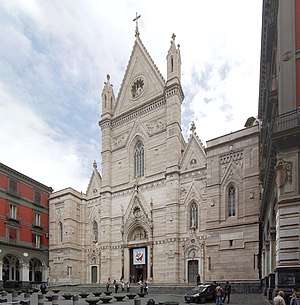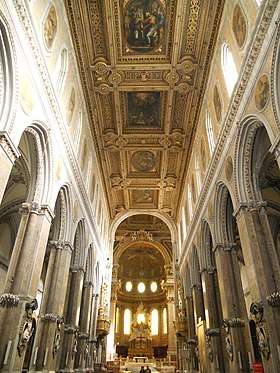Naples Cathedral
Naples Cathedral (Italian: Duomo di Napoli, Cattedrale di Santa Maria Assunta or Cattedrale di San Gennaro; Neapolitan: Viscuvato 'e Napule) is a Roman Catholic cathedral, the main church of Naples, southern Italy, and the seat of the Archbishop of Naples. It is widely known as the Cattedrale di San Gennaro, in honour of Saint Januarius, the city's patron saint.
| Cathedral of the Assumption of Mary Cattedrale di Santa Maria Assunta | |
|---|---|
 The façade of Naples Cathedral. | |
| Religion | |
| Affiliation | Roman Catholic Church |
| Province | Archdiocese of Naples |
| Ecclesiastical or organizational status | Cathedral |
| Year consecrated | 13th century |
| Status | Active |
| Location | |
| Location | Naples, Italy |
| Geographic coordinates | 40.8525°N 14.2596°E |
| Architecture | |
| Type | Church |
| Style | Gothic, Renaissance, Baroque, Neo-gothic |
| Groundbreaking | 13th century |
| Completed | 19th century |

.jpg)
History
The present cathedral was commissioned by King Charles I of Anjou. Construction continued during the reign of his successor, Charles II (1285-1309) and was completed in the early 14th century under Robert of Anjou. It was built on the foundations of two palaeo-Christian basilicas, whose traces can still be clearly seen. Underneath the building excavations have revealed Greek and Roman artifacts.
The Archbishop's Palace adjoins the cathedral.
Interior and artwork
The main attraction of the interior is the Royal Chapel of the Treasure of San Gennaro, with frescoes by Domenichino and Giovanni Lanfranco, altarpieces by Domenichino, Massimo Stanzione and Jusepe Ribera, the rich high altar by Francesco Solimena, the bronze railing by Cosimo Fanzago and other artworks, including a reliquary by 14th-century French masters.
Other artworks include an Assumption by Pietro Perugino, canvasses by Luca Giordano and the palaeo-Christian baptistery, with mosaics from the 4th century. The main chapel is a restoration of the 18th century, with a Baroque relief by Pietro Bracci. The Minutolo Chapel, mentioned in Boccaccio's Decameron, has 14th-century frescoes.
The crypt is by the Lombard Tommaso Malvito. The façade was reworked by Enrico Alvino in the late 19th century, but retains the 15th century portal, including some sculptures by Tino da Camaino.
Miracle of the Blood
The church houses a vial of the blood of Saint Januarius which is brought out three times a year, on the first Saturday in May, on 19 September and 16 December, when the dried blood usually liquefies. If the blood fails to liquefy, then legend has it that disaster will befall Naples.[1]
A recent hypothesis by Garlaschelli, Ramaccini, and Della Sala is that the vial contains a thixotropic gel,[2][3] he also explained on the Blood Miracle of Riddles of the Dead series on National Geographic Channel.[4] In such a substance viscosity increases if left unstirred and decreases if stirred or moved. Researchers have proposed specifically a suspension of hydrated iron oxide, FeO(OH), which reproduces the color and behavior of the 'blood' in the ampoule.[5] The suspension can be prepared from simple chemicals that would have been easily available locally since antiquity.[6][7] On March 21, 2015, the blood in the vial appeared to liquify during a visit by Pope Francis. This was taken as a sign of the saint's favour of the pope. The blood did not liquify when Pope Benedict XVI visited in 2007.
Burials
- Saint Januarius
- Pope Innocent IV
- Charles I of Naples
- Saint Restituta
- Sisto Riario Sforza
- Rinaldo Piscicello
- Ascanio Filomarino
- Alfonso Castaldo
References
- Januarius#The Blood Miracle
- Garlaschelli, L.; Ramaccini, F.; Della Sala, S. (1994). "The Blood of St. Januarius". Chemistry in Britain. 30 (2): 123. Archived from the original on April 26, 2017. Retrieved July 28, 2009.
- Christopher, Kevin (2000-09-22). "The Miracle Blood of Saint Januarius". Committee for Skeptical Inquiry. Archived from the original on 2007-02-06. Retrieved 2007-03-02.;
- National Geographic Channel - Riddles of the Dead - Blood Miracle
- Luigi Garlaschelli (2002), Sangue Prodigioso. La Chimica e l'Industria., 84 (6), p.67-70 Online version Archived 2011-01-08 at the Wayback Machine accessed on 2009-06-20. (In Italian).
- Epstein, Michael; Luigi Garlaschelli (1992). "Better Blood Through Chemistry: A Laboratory Replication of a Miracle" (PDF). Journal of Scientific Exploration. 6: 233–246. Archived from the original (PDF) on 2009-07-17. Retrieved 2007-03-02.
- Owen, Richard (2005-09-20). "Naples blood boils at miracle's 'debunking'". The Times. London: Times Newspapers Ltd. Retrieved 2007-03-02.
| Wikimedia Commons has media related to Naples Cathedral. |